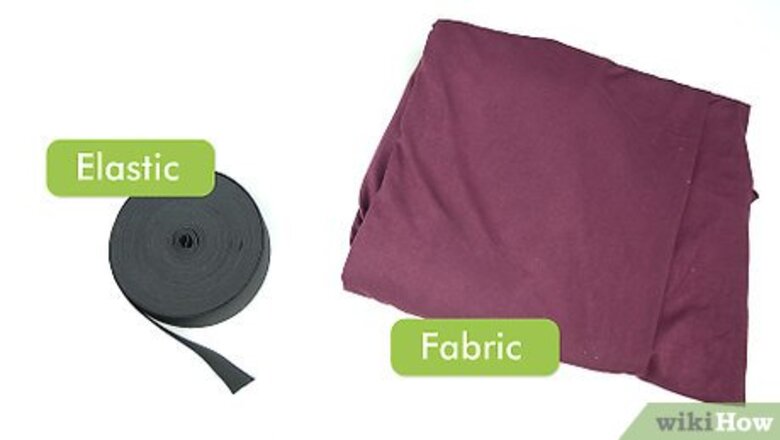
views
- Use a soft measuring tape to measure your hips, waist, and leg length. Then use those measurements to cut 2 identical rectangles from a sheet of fabric.
- Sew the 2 pieces of fabric together at the sides. Then fold the top down by 0.5 inches (1.3 cm) and sew it in place to create an elastic band.
- Fold the bottom up by 0.5 inches (1.3 cm) and sew it to make a hem. Then feed a length of elastic through the band, snip it off, and sew the band shut.
Making a Gathered Skirt
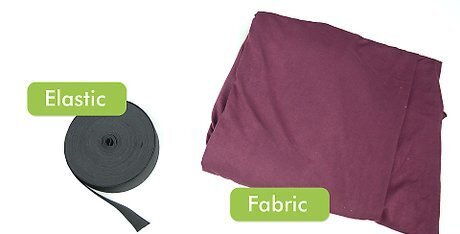
Choose your materials. You can use any fabric to create this skirt, and you will need elastic that measures ½ inch -1 inch (2.5 cm) wide. To create a more structured skirt, use a stiffer fabric material. To create a looser more flowy skirt, use a light and airy fabric. Stretch fabrics make wonderful slim or pencil style skirts, while a woven fabric is great for gathering.
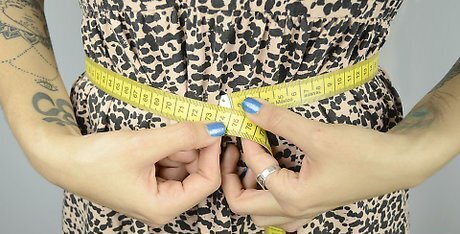
Take your measurements. Use a soft measuring tape to find the distance around the widest part of your hip, smallest part of your waist, and the total length of the skirt. To find the length, you can use the measuring tape from your hips to the desired level on your legs and add 2½ inches extra for the elastic casing.
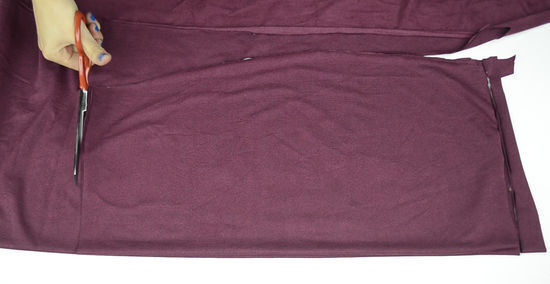
Cut your fabric and elastic. Use your measurements to cut 2 large rectangular pieces of fabric the length of your choice by the distance around your hips. Cut your elastic band to be the length of your hips, minus one inch (if your hips measure 30 inches, your elastic should be cut to 29 inches).
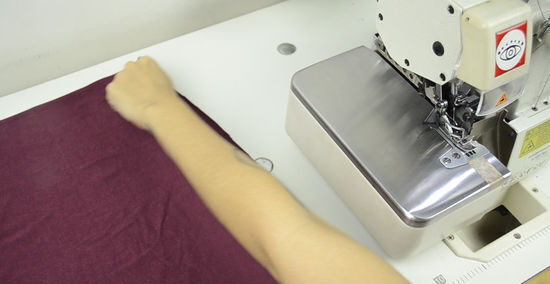
Sew the side seams. Lay the two rectangular pieces on top of each other so that they are even. Give each piece a ½ inch seam allowance, and sew them together. Use an iron to flatten the seams when you are finished (or before if you are having trouble keeping your fabric flat).
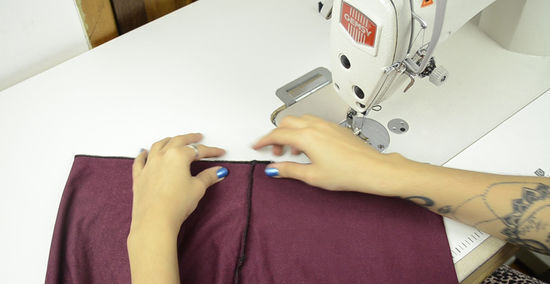
Create the elastic casing. The elastic of this skirt will be hidden inside the fabric, so you will need to make the fabric casing to cover it up. Fold the top ½ inch of fabric over and use an iron to press it. Then, fold the fabric an additional 2 inches (5.1 cm); use a top stitch to secure this section along the pressed area to the body of the skirt. Leave a 4 inch (10.2 cm) opening near one of the seams to add the elastic.
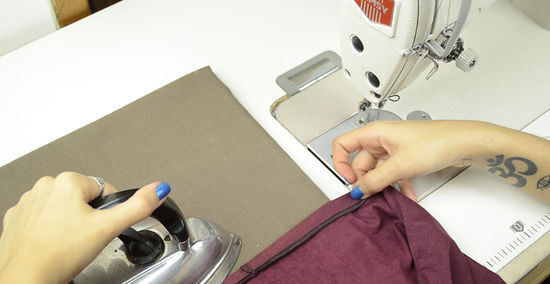
Sew the hem. Fold the bottom section of the skirt over ½ inch. Use your iron to press the fabric and pin if necessary to hold it in place. Use a top stitch to sew the hem in place.

Add the elastic. Slide your cut elastic into the elastic casing you’ve created. Pull the elastic through the loop, and when you get to the other side sew the two pieces together using a straight stitch. Use a safety pin to hold the elastic in place while you slide it through, if necessary. Use a top stitch to close the opening, and a backstitch to reinforce the seam.
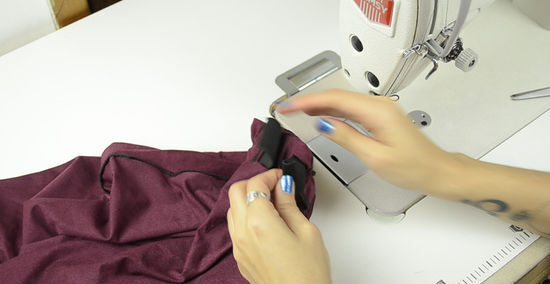
Finish the waistband. Adjust the gathered ruffles around the top of the waistband so that they are evenly spaced. When you have the gathers adjusted to your liking, stitch in the low areas to attach the ruching to the elastic. Don’t stitch across the gathers as this will flatten them out; only stitch in the spaces between the gathers.
Making a Circle Skirt
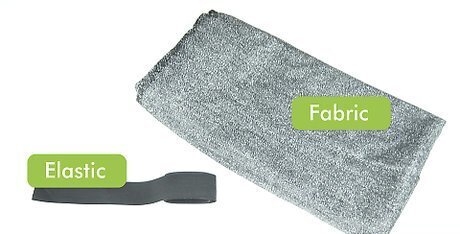
Pick out your materials. Circle skirts are known for their flowy appearance, so it is best to choose a material that isn’t too heavy or stiff(we recommend flounced garments). The waistband is made from exposed elastic, so choose an elastic in a width and color that you like. A wide waistband measuring 3 inches (7.6 cm) or more is a fun way to top off your skirt.
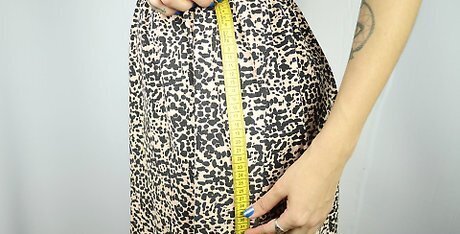
Take your measurements. Use a soft measuring tape around your hips where you would like the skirt to sit, typically the widest part. Because this is a circle skirt, a bit of geometry is necessary to find the measurements. To find the radius of the skirt, take your hip measurement and add two inches. Then, divide this number by 6.28; the answer is the radius of your circle. For example, if your hips measure 30 inches (76.2 cm), add two additional inches and divide by 6.28 (32 / 6.28). This will give you a radius of about 5.1 inches (13.0 cm). Measure the elastic by adding one inch for a seam allowance to your total hip measurement. If your hips measure in at 30 inches (76.2 cm), your elastic should be measured and cut to 31 inches (78.7 cm). Measure the length of the skirt by using a soft measuring tape to find the distance from your hips to your desired end point. Add an extra inch of length for seam allowance.
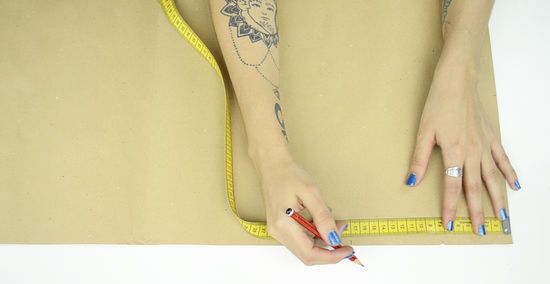
Make your paper pattern for the hip radius. You will only need to create a paper cut for ¼ of the skirt, so choose a piece of paper large enough to occupy a sketch of that size. Use your measuring tape and place your pencil in the hole at the end. Find the measurement for your radius (or as close as you can) and hold this spot on the measuring tape to the bottom left corner piece of your paper. As you hold the tape with your left hand. use the pencil in the hole to swivel from edge to edge of the paper with your right hand. You should be left with a quarter of a circle, with the corner being the center point.
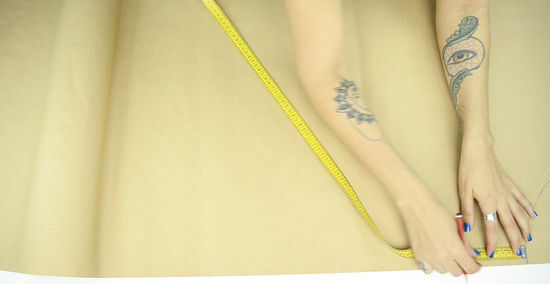
Add your length radius to the pattern. Choose the length you would like for your skirt. Use your measuring tape to mark this distance from the line you just made for your hip radius in another ¼ circle. Draw from edge to edge of the paper, with the starting point of the distance being the line for your hip measurement. You should be left with a rainbow shaped ¼ circle strip from edge to edge of your paper.
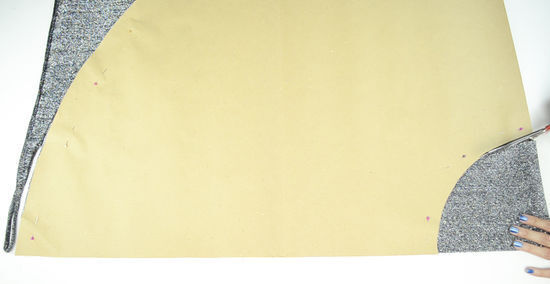
Cut your pattern and fabric. Cut out your paper along both of the lines you created, making a curved band. Fold your fabric in half and then in half again, leaving you 4 folded sections. Place the paper pattern over the corner where all the fabric is connected, and cut out along the outside of the paper. When you unfold the fabric, you should have a large ring or donut shaped piece of material.
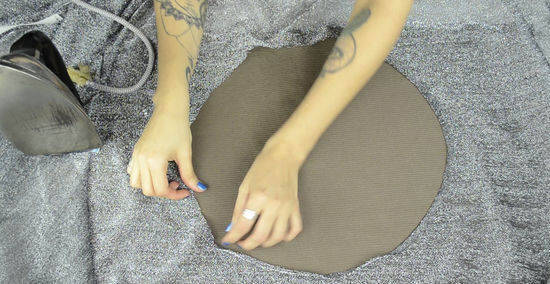
Iron down the waist. To finish the waistband section of fabric, you will need to press and serge the edges. This will keep the raw edges from unraveling through wearing and washing. Fold down a section of fabric ¼ inch from the top of the skirt and use an iron to flatten it out. Then use a serger (if you have one available) or use a zig-zag stitch to finish the seam.
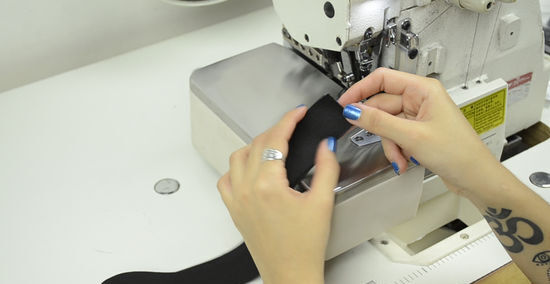
Sew the elastic. The elastic is a bit smaller that the fabric around the waist to allow give when you put the skirt on. Because of that, the two ends must be sewn together first before being added to the skirt. Fold the elastic in half, and use a straight stitch to sew the pieces together with a ½ inch seam allowance. Then, fan the edges out away from each other and sew them flat back onto the elastic, so that there isn’t a bump on the seam when the skirt is worn.
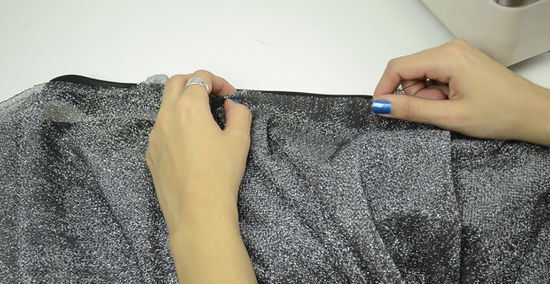
Pin the elastic to the fabric waistband. Your skirt should gather slightly around the elastic because of the enlarged size. Place the waistband along the top edge of the elastic, and pin the skirt evenly around. Use as many or as few of the pins as you need in order to get an even gather around the entirety of the waist.
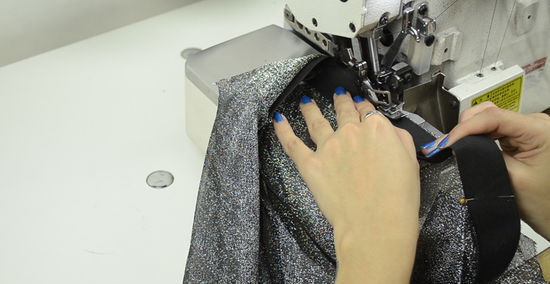
Sew the waistband. With your elastic pinned to the fabric, begin to sew around the edge with the elastic on the outside of the skirt. As you sew, stretch the elastic so that there are no loose sections where the fabric and elastic are not attached. You can use a straight or a zigzag stitch for this.
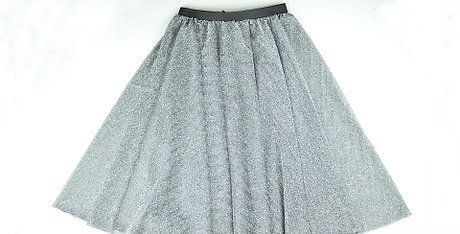
Hem the skirt. Fold over the bottom ¼ inch of the edge of the skirt and use an iron to flatten it out. Then fold this section over again, and use a straight or zigzag stitch to hem it all the way around the edge.
Making a Maxi Skirt
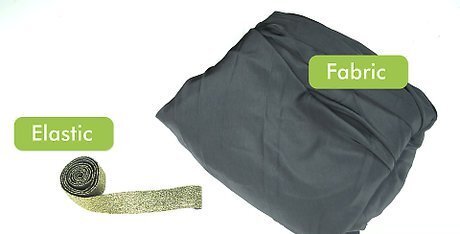
Choose your materials. Maxi skirts are very long and need fabric that is a bit heavier to weigh them down. Find a fabric that is a bit thicker so that it is not see-through and will have enough weight to keep the skirt from blowing around. Use a wide band of elastic to create the waistband at the top; the elastic will be exposed, so choose a color that matches the fabric of your skirt. Try to choose fabric that is large enough to be cut in a single piece. This maxi skirt tutorial uses a single length of fabric, rather than two (or more) smaller pieces sewn together.
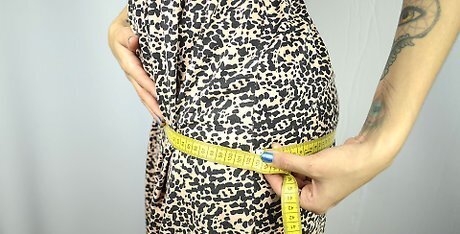
Take your measurements. The two necessary measurements to make a basic maxi skirt are your hips and length. Use a soft measuring tape around the widest part of your hips where your skirt will sit. Then, measure from that point down to your ankles (or where you want the skirt to end). This measurement will probably range somewhere from 40–70 inches (101.6–177.8 cm) depending on your height. Measure your elastic for the waistband by taking one inch off your hip measurement. This will make your elastic just tight enough that it won’t slide off or create an awkwardly loose band. Add one inch of extra fabric to both the length and the width for seam allowances.
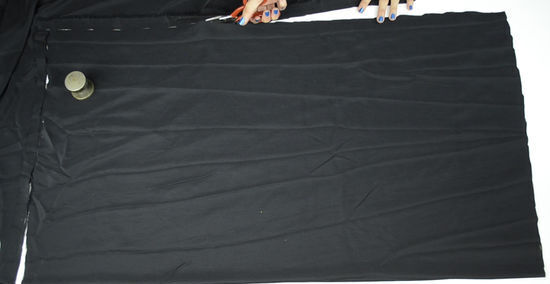
Cut your fabric. You should measure a large rectangular stretch of fabric with the width being the measurement around your waist and the length being your desired length of the skirt. Cut out this shape and fold it in half with the two cut ends touching.
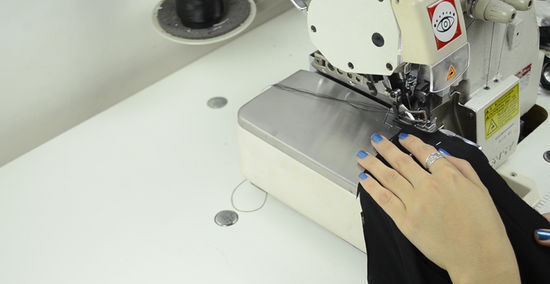
Sew along the length. Fold over ½ inch of fabric on either edge of the length and iron it down to create a flat seam. Then use a zigzag stitch along this length to secure the two sides of the fabric, creating a tube.
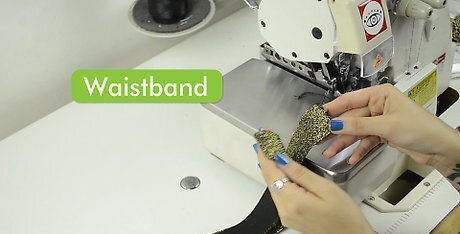
Start the waistband. Turn the tube of fabric inside out so that you can work along the top stretch of the material. If you have a serger, serge the edge of the fabric to keep it from fraying. Otherwise, use a zigzag stitch to stabilize the ends.

Sew the elastic. Take your cut piece of elastic and fold it in half, with the two cut ends laying on top of each other. Use a straight stitch ¼ of an inch from the edge of the cut. Then, turn the elastic loop inside out and fan the two bits leftover from the sewn ends away from each other and use a zigzag stitch to attach them back onto the band. This will cause the seam to lay flat and be more comfortable and attractive when the skirt is worn.
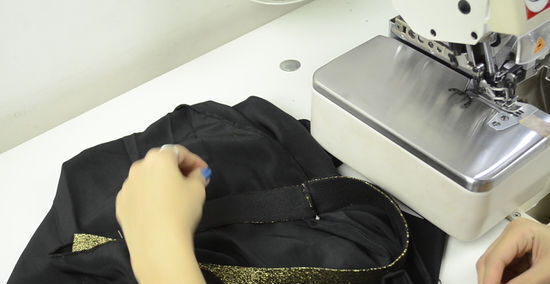
Attach the elastic to the waistband. Place the top of the skirt inside the elastic band and pin it in place. There might be a bit more fabric than elastic band width, so pin it evenly around so that any gathers that may form are equidistant from each other.
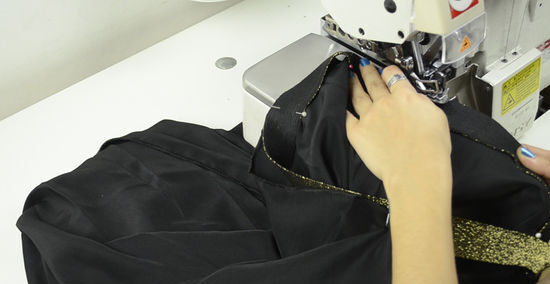
Sew on the elastic band. Use a straight stitch around the width of the skirt ¼ of an inch up from the bottom of the elastic. Remove the pins as you go, making sure to keep a straight line so that your waistband is even.

Finish the hem. Fold the bottom ½ inch of the skirt up and iron it to create the hem. Use a zigzag stitch or serger to keep the bottom edge of the fabric from fraying. Then, use a straight stitch to attach it to the body of the skirt.










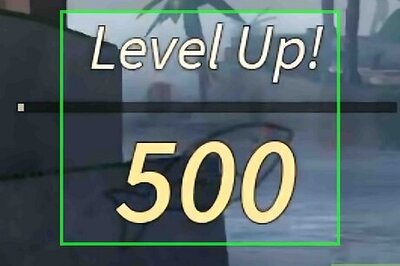

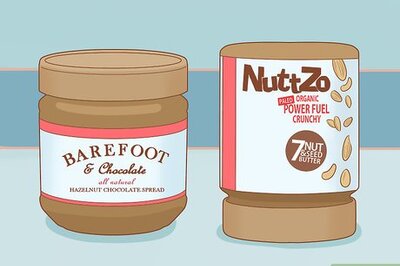





Comments
0 comment